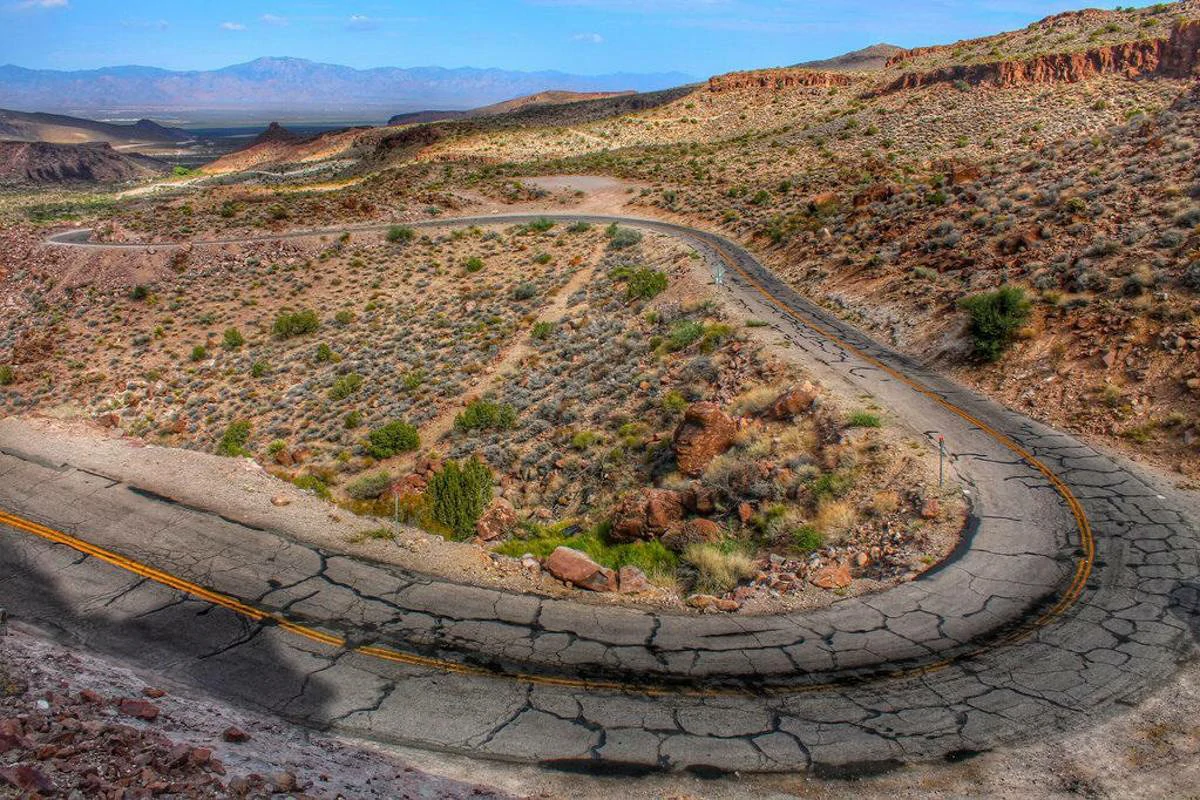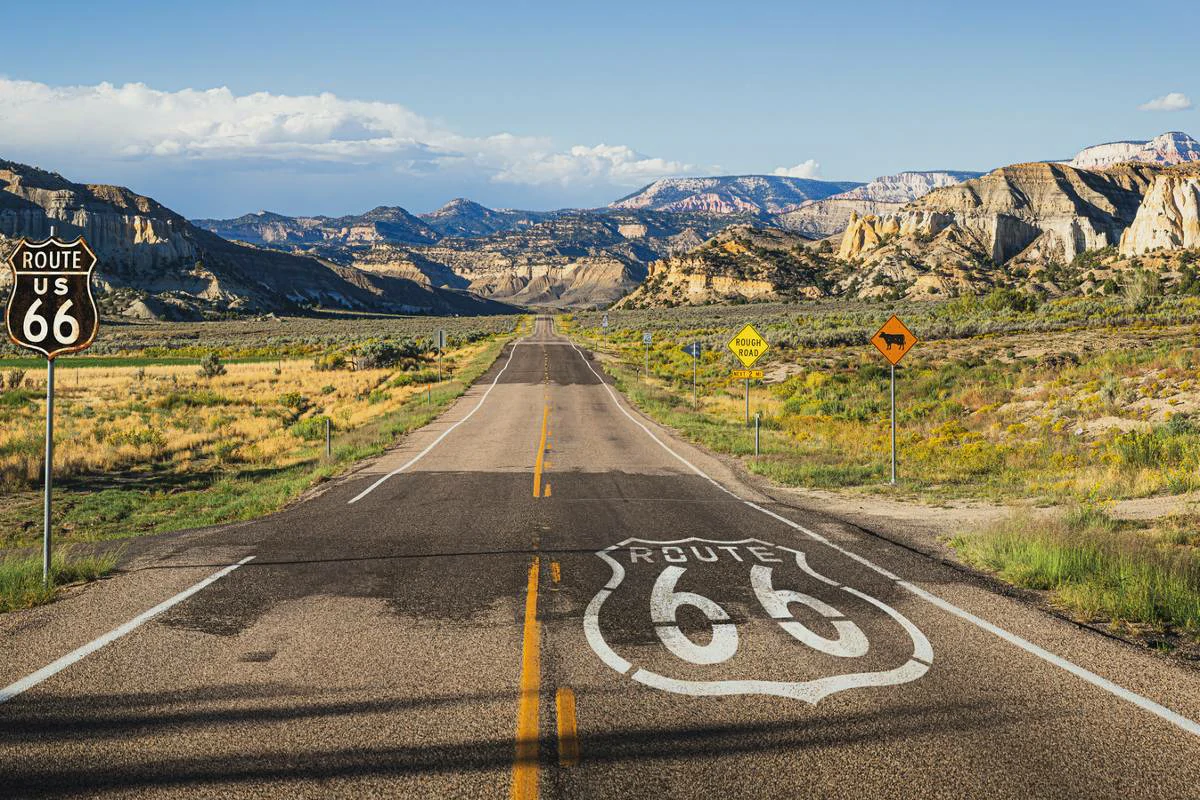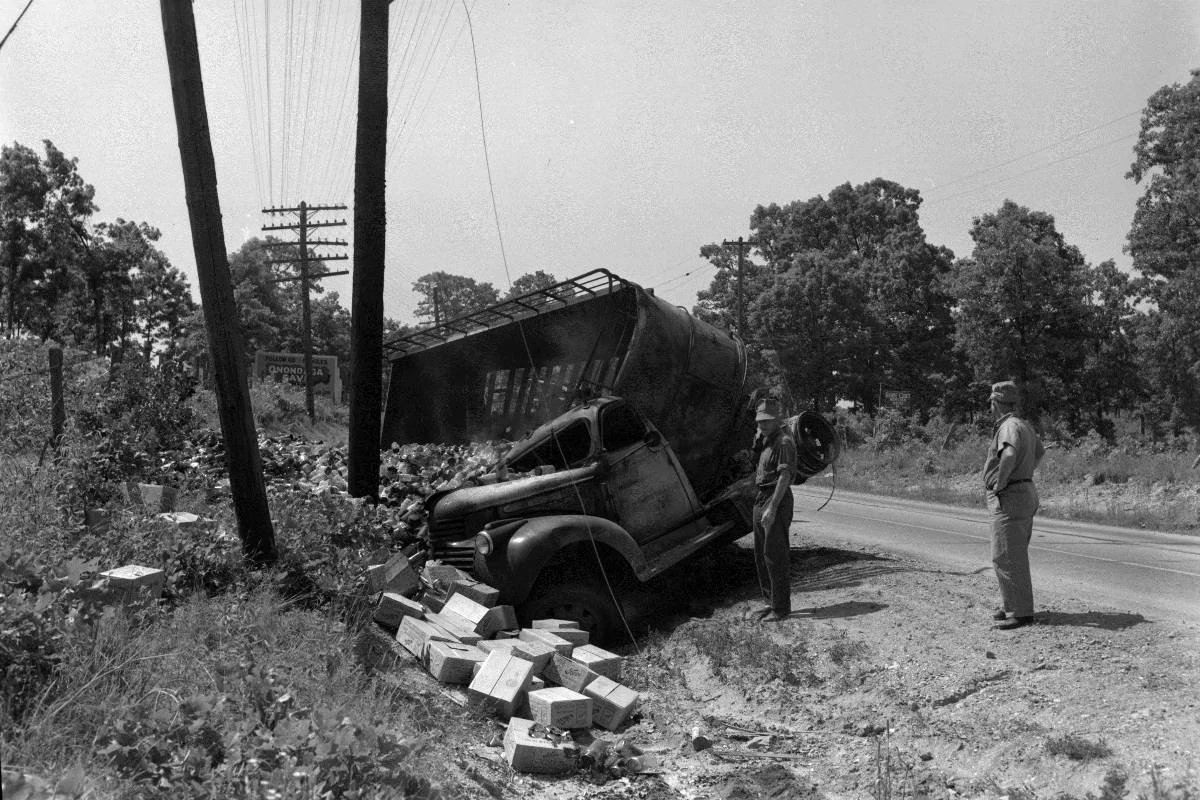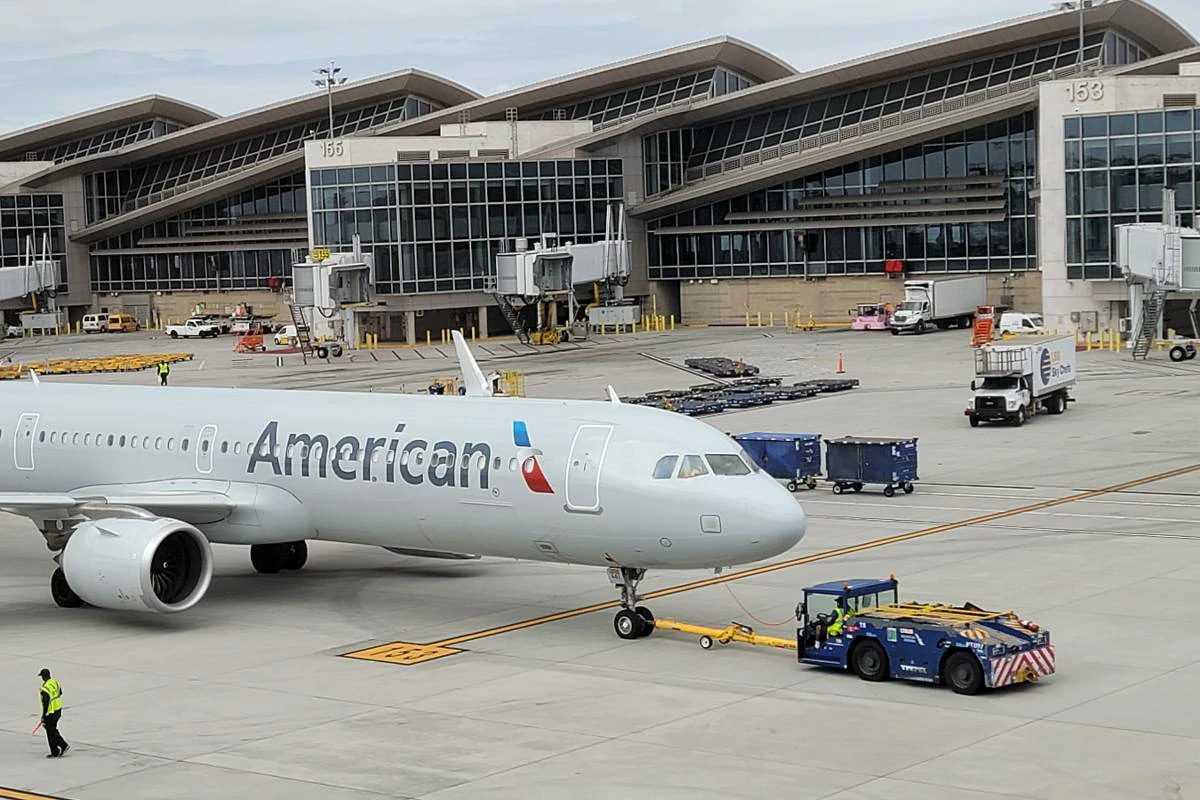Why is Route 66 dangerous? Answer is – Route 66 holds a nostalgic place in American history, but it also has a reputation for danger. This is due to a combination of factors. Some sections of the road are poorly maintained and have deteriorated over time. The route passes through remote areas with limited services, increasing the risk of breakdowns or accidents far from help. Additionally, Route 66’s popularity attracts both experienced and less-prepared travelers, and some may underestimate the challenges a long road trip on an older highway can present.
Summary
- Route 66 is an iconic American highway but has potential risks.
- Road conditions can be poor in some sections, with hazards like potholes and narrow lanes.
- The route goes through remote areas, making assistance harder to find in case of problems.
- Weather conditions can be extreme and unpredictable, especially in “Tornado Alley.”
- The popularity of Route 66 can lead to traffic congestion and inexperienced drivers.
Why is Route 66 Dangerous?

The allure of Route 66
Route 66, also known as the “Mother Road” or the “Main Street of America”, is a road steeped in American lore. Commissioned in 1926, it wound its way from Chicago to Los Angeles, cutting through the heart of the country.
This nearly 2,500-mile stretch of highway became synonymous with westward expansion, the freedom of the open road, and a golden era of American car culture. Images of classic diners, quirky roadside attractions, and neon-lit motels are forever ingrained in the collective imagination.
The allure of Route 66 persists. It offers a chance to slow down, experience remnants of a bygone era, and connect with small-town communities often bypassed by modern interstates.
The call of Route 66 lures nostalgic travelers, road trip enthusiasts, history buffs, and those seeking a more authentic slice of Americana.
Why the “Mother Road” can also be risky
However, the romance of Route 66 can sometimes obscure the very real risks associated with traveling this historic route. It’s crucial to remember that the road wasn’t designed for modern traffic volumes or speeds. Its charms are also its potential dangers.
Here’s why even the most seasoned traveler needs to approach Route 66 with a healthy dose of caution and preparation:
Time and neglect: Route 66 was officially decommissioned in 1985. While dedicated efforts preserve some sections, others have inevitably fallen into disrepair. Drivers need to be aware of potholes, crumbling pavement, and narrow lanes.
Remoteness: The route traverses vast stretches of desert, open plains, and rural landscapes. Long distances between towns, unpredictable cell reception, and a lack of immediate services make breakdowns or emergencies potentially more difficult to manage.
Extreme Weather: Traveling through “Tornado Alley” in the Midwest or the scorching deserts of the Southwest presents unique weather challenges. Sudden storms, flash floods, intense heat, and even winter hazards in some areas can quickly turn a dream road trip into a dangerous situation.
Tom Droz Expert Opinion
“Route 66 is an iconic symbol, but it’s not Disneyland,” warns Tom Droz, author of “Route 66 Then and Now”. “Travelers need to understand it’s a real road with real risks. Nostalgia alone won’t get you to California safely.”
Route 66 Road Conditions

Route 66 is a patchwork highway. Some sections have been well-preserved or restored, while others are in a distressing state of disrepair. Understanding potential road hazards is crucial to staying safe on your journey.
1. Deterioration and lack of maintenance
While significant efforts go into preserving “The Mother Road,” funding is limited, and time is not kind to asphalt. These factors contribute to a range of hazards for travelers:
Potholes: These can range from annoying jolts to tire-damaging surprises. Be extra cautious in winter and after heavy rains, as potholes can be obscured by water or snow.
Crumbling pavement: Uneven surfaces, crumbling asphalt, and sudden lane shifts are unfortunately common in some areas of Route 66.
Overgrown vegetation: Lack of maintenance can lead to vegetation obscuring road edges, signs, and potential hazards like debris or animals.
Bridge concerns: Some historic bridges weren’t designed to handle modern traffic loads or have suffered from deterioration. Keep an eye out for weight limits or warning signs.
2. Narrow lanes and curves
Route 66 predates the era of wide interstates and gentle turns. Be prepared for:
Narrow lanes: Expect lanes significantly narrower than modern highways. Passing can be difficult and visibility in oncoming traffic may be limited.
Sharp curves: The route includes winding stretches, particularly in hilly or mountainous regions. Take these turns slowly and be very aware of your blind spots.
3. Limited shoulders and roadside hazards
Modern highways are often designed with wide shoulders for emergency pull-offs. This is not always the case with Route 66.
Lack of shoulders: In some sections, breakdowns mean pulling off into unpaved or unstable ground. This can be dangerous near traffic or in bad weather.
Drop-offs: Steep drop-offs at the road’s edge are especially common in mountainous areas. Always stay aware, particularly at night.
Debris: From animal carcasses to old tires, debris on the road presents a greater risk where shoulders are minimal.
4. Ghost towns and abandoned stretches
The decline of Route 66 left some towns faded remnants of what they once were. While picturesque, they pose unique issues:
Unexpected road conditions: Abandoned sections of Route 66 may be impassable, covered in sand drifts, or simply end abruptly. Research ahead of time or seek local advice.
Limited services: Don’t count on finding gas, water, accommodations, or help in deserted areas.
Structural dangers: Old buildings or ghost town attractions may be unstable. Avoid entering without ensuring they are safe and maintained.
Sarah Jones Expert Opinion
“Route 66 can feel like stepping back in time, for better and for worse,” says Sarah Jones, historian and Route 66 preservationist. “The road doesn’t adhere to modern standards. Drivers need to slow down, be hyper-aware, and respect the age of the highway itself.”
Important Note: Always check the latest road conditions before venturing onto any stretch of Route 66. State transportation websites or Route 66 associations can provide the most up-to-date information:
- National Route 66 Federation
- State-specific Departments of Transportation (Example: Illinois DOT)
Remote Locations and Lack of Services

One of Route 66’s undeniable charms is its passage through vast and often sparsely populated landscapes. However, this remoteness also creates logistical and safety challenges modern travelers need to address carefully.
1. Long distances between towns and gas stations
Services you might take for granted on an interstate can be few and far between along the “Mother Road.” Be prepared for:
Stretches without gas: Even with careful planning, gas stations can be surprisingly distant. Never assume there’s one “just around the corner.” Top up your tank frequently, especially before venturing onto less-traveled stretches.
Unpredictable hours: Small town gas stations or stores may have limited or irregular hours. Don’t always count on a 24/7 option, even for basic supplies.
Limited food options: You may go long stretches without restaurants, especially off-season or outside of touristy areas. Carry ample water and snacks in your vehicle.
2. Limited cell phone reception
Don’t rely on your smartphone to bail you out of every situation on Route 66. Cell service can be nonexistent for many miles, particularly in remote areas.
Dead zones: Expect that you’ll encounter stretches without any signal. Download offline maps ahead of time and let someone know your planned route and check-in times.
Outdated maps: Even if a town is marked on your mapping app, that doesn’t guarantee a cell signal to call for help if needed. Carry a paper map as backup.
Phone battery conservation: Don’t waste battery life when service is poor. Turn off unnecessary data usage, and consider bringing a portable charger.
3. Reduced availability of emergency services
Rural areas often have fewer resources and longer response times in the case of an emergency. This includes:
Long waits for assistance: Help may be a significant distance away. Response times for tow trucks, ambulances, or law enforcement can be hours instead of minutes.
Limited medical facilities: Small towns may have rudimentary clinics or no medical care at all. Prepare a first-aid kit, and those with specific medical needs should research hospitals along the route.
Roadside assistance variability: Don’t assume tow truck availability or a quick fix at smaller garages. Carry basic vehicle repair tools and supplies.
Emily Thomas Expert Opinion
“Route 66 is an adventure, but be a self-reliant adventurer,” emphasizes Emily Thomas, a park ranger at Petrified Forest National Park, which Route 66 traverses. “It’s the classic ‘ounce of prevention’ situation. Carry supplies, know your limits, and don’t expect instant assistance like you would in a city.”
Important Resources
- Route 66 Associations often have safety guides and updated information on road conditions and services.
- Downloadable offline maps will be a lifesaver in dead zones: Google Maps allows offline use.
Extreme Weather Conditions

Route 66’s journey across the heart of America exposes travelers to a remarkably diverse and sometimes volatile range of weather conditions. Planning ahead and taking local forecasts seriously is crucial for staying safe.
1. Tornado Alley and severe storms
A significant portion of Route 66 falls within ‘Tornado Alley,’ a region stretching across the Great Plains with a high frequency of tornadoes, particularly in spring and early summer. Additionally, severe thunderstorms can occur year-round.
Tornado risks: Tornadoes are unpredictable and destructive. Heed tornado watches and warnings without hesitation. Seek shelter in sturdy buildings if possible. Learn more on the National Weather Service’s Tornado Safety page.
Thunderstorms with hail and lightning: Even storms without tornadoes can pack a punch. Hail can damage vehicles, and lightning is a serious hazard outdoors. If stuck in your car, it’s the safest place to be during lightning.
High winds: Open plains can bring sudden, strong wind gusts making driving difficult, especially for large vehicles.
2. Heat waves and desert conditions
Sections of Route 66, particularly in the Southwest, cross through arid desert environments. This presents a unique set of challenges for travelers:
Dehydration: The combination of heat, dry air, and exertion can dehydrate you faster than you realize. Drink water frequently, even before you feel thirsty.
Heat exhaustion/heat stroke: These are serious medical concerns in extreme heat. Know the symptoms.
Vehicle breakdowns: Overheating vehicles are a major hazard. Ensure your car is well-maintained, and carry extra coolant and water.
Sun exposure: Minimize your time in direct sun, wear a hat and protective clothing, and utilize sunscreen.
3. Flash flooding
Paradoxically, deserts and some semi-arid regions along Route 66 can experience sudden and dangerous flash flooding. This is especially true in areas with canyons and arroyos.
Underestimating the danger: Even seemingly dry stream beds can turn into raging torrents in minutes during heavy rainfall.
Road wash-outs: Flash floods can damage or destroy roads entirely. Do not attempt to cross flooded roadways.
Warnings may be limited: Flash floods are often localized events, and warnings might not reach you in time.
4. Winter hazards (snow and ice)
While Route 66 conjures images of sun-drenched landscapes, higher elevations and northern sections experience freezing temperatures, snow, and ice in winter.
Variability along the route: You might encounter sunny 70-degree weather in one state and a blizzard in the next. Check forecasts for each leg of your journey.
Black ice: This is a particular danger on shaded roads and bridges. Slow down and avoid sudden acceleration or braking when temperatures are near freezing.
Road closures: Winter storms can lead to closures, sometimes stranding travelers on remote stretches of Route 66.
Janice Dean Expert Opinion
“Never underestimate the power of weather on Route 66,” warns meteorologist Janice Dean, who has covered numerous severe weather events in the region. “Travelers need to monitor forecasts like a hawk and have the flexibility to amend plans if conditions turn dangerous.”
Resources for Weather Monitoring
- National Weather Service (NWS): Provides alerts, watches, and forecasts for your specific location
Traffic and Driver Behavior

The popularity of Route 66 can lead to traffic situations that range from surprisingly congested to unexpectedly hazardous. It’s vital to stay vigilant and adjust your driving accordingly.
1. Traffic congestion
While Route 66 avoids the constant crush of major interstates, specific areas can become surprisingly busy, especially during peak season or near popular attractions.
Tourist hubs: Expect heavier traffic within towns heavily geared towards Route 66 tourism. Patience is essential, as narrow streets may further exacerbate congestion.
Special events: Festivals, car shows, and rallies along Route 66 will bring an influx of vehicles. Do your research ahead of time to avoid getting caught in traffic unexpectedly.
Construction and delays: With ongoing maintenance and preservation efforts, road work can be a reality on Route 66. Factor in extra time for potential delays.
2. Inexperienced drivers on a challenging road
Route 66 attracts a wide spectrum of drivers, some less prepared than others for its unique demands. Be cautious of:
Novice road trippers: Those on their first extensive road trip may be less skilled at judging distances, managing fatigue, and handling older roads.
Large RVs and campers: Some drivers underestimate the difficulty of navigating larger vehicles on Route 66’s narrow stretches or older bridges.
Drivers unfamiliar with US roads: International travelers may find left-side driving or specific traffic laws a challenge to adapt to quickly.
3. Distracted driving
The allure of Route 66’s sights can unfortunately lead to the most common hazard of all: drivers not paying adequate attention to the road.
Sightseeing while driving: The urge to take in the scenery, snap photos, or consult guidebooks while behind the wheel is a dangerous temptation.
Smartphone usage: Texting, navigation adjustments, or social media updates while driving remain major hazards, even on scenic routes.
Drowsy driving: The long driving days that often come with a Route 66 adventure increase the risk of fatigue-based accidents.
Mike Nelson Expert Opinion
“Route 66 brings out a sense of adventure, but that can’t replace common sense behind the wheel,” says Officer Mike Nelson of the Arizona Highway Patrol. “The beauty of the road is a distraction itself – pull over to enjoy it safely.”
Resources for Staying Safe
- Distraction.gov: Offers information and resources combatting distracted driving.
- National Highway Traffic Safety Administration (NHTSA): Provides statistics and safety campaigns on drowsy driving and other dangers.
Safety Tips for Traveling Route 66

The best defense against the risks of Route 66 is preparation. Taking these steps proactively will minimize stress and increase the likelihood of a smooth, unforgettable adventure.
1. Thorough vehicle preparation
Your car is your lifeline on Route 66. Make sure it’s up to the task before you set off:
Professional maintenance: Schedule a full inspection with your mechanic well in advance of your trip. Address any potential problems.
Tires and brakes: Ensure your tires have adequate tread and are properly inflated. Check brake function and responsiveness.
Fluids and essentials: Top up oil, coolant, and other essential fluids. Replace windshield wipers if needed.
Consider a rental: If your car has high mileage or a history of issues, renting a well-maintained vehicle might be a safer (and less stressful) option.
2. Planning your route and accommodations
Careful planning lessens the chance of unpleasant surprises and allows you to tailor your trip to your risk tolerance level.
Detailed map and backup: Carry a detailed paper map in addition to any digital navigation you use. Familiarize yourself with the route and major towns.
Break it down: Avoid overly ambitious daily mileage goals. This reduces fatigue and gives you leeway in case of delays.
Accommodation bookings: Especially in peak season, don’t assume you’ll find last-minute vacancies. Pre-booking gives you peace of mind.
Research and realism: Learn about the areas you’ll traverse. Be honest about your comfort level with remote stretches and adjust your itinerary accordingly.
3. Carrying emergency supplies
Hope for the best, but prepare for the unexpected. A well-stocked vehicle could make the difference between a minor inconvenience and a major crisis:
First-aid kit: Include basics for cuts, scrapes, insect bites, and any specific medical needs.
Water and non-perishable food: More than just snacks! Carry enough to sustain you for several days if stranded.
Vehicle toolkit: Jumper cables, flares, basic tools, and a flashlight are essential. Know how to use them.
Warmth and weather gear: An extra blanket, rain gear, gloves, and a hat can be vital if weather changes or you’re stuck waiting for assistance.
4. Staying alert and aware of surroundings
Even the most prepared traveler needs to stay actively engaged and vigilant on Route 66.
Frequent breaks: Combat fatigue by taking short breaks every two hours or so. Stretch, get fresh air, and rehydrate.
Fuel up early: Don’t wait until your tank is near empty to look for gas.
Animal awareness: Be especially alert for wildlife at dawn, dusk, and in rural areas.
Share your itinerary: Let a trusted person know your planned route and estimated travel dates. Check in with them periodically.
5. Resources for help and information
Knowledge is power. Know where to turn for help if needed, and what information sources can help you stay informed about your route:
Route 66 Associations: Their websites often have safety guides and updated information on road conditions
State-specific Departments of Transportation: Check websites for your route’s states – they post alerts, road closures, and construction zones .
National Weather Service: Your go-to for forecasts, watches, and warnings.
Roadside assistance programs: Ensure your membership is current (AAA, etc.) or research reputable providers offering coverage on Route 66.
Lisa Peterson Expert Opinion
“An ounce of prevention beats a pound of cure on Route 66,” says Lisa Peterson, author of the guidebook “50 States, 5000 Ideas”. “Don’t let the romance lull you into complacency. Smart preparation lets you truly enjoy the ride.”
Conclusion
Balancing nostalgia with a realistic approach to safety
Route 66 holds an undeniable place in American history and the imagination of travelers worldwide. This legendary highway offers a glimpse into bygone eras, a chance to explore the heartland, and the freedom of the open road.
However, it’s vital to remember that the route wasn’t designed for modern traffic or expectations. By acknowledging the risks – from deteriorating roads to remote stretches and unpredictable weather – we empower ourselves with the best tools for a safe and unforgettable journey.
Thorough preparation, a respect for the age of the highway, and staying alert make all the difference. When we approach Route 66 with a blend of romantic spirit and practical awareness, its unique charms reveal themselves without compromising our well-being.
What does it mean to travel Route 66 responsibly?
- Understanding that it’s a journey, not just a destination. Embracing the slower pace and building in contingency time.
- Choosing a travel style that matches your experience level and risk tolerance.
- Supporting local businesses along the route, helping preserve its communities.
- Practicing “Leave No Trace” principles, minimizing your impact on the environment.
FAQs
Q: Is Route 66 safe for solo travelers?
It can be, but extra precautions are essential. Share your detailed itinerary with someone, favor well-lit, populated areas for overnight stops, and learn some basic self-defense.
Q: Can you still drive the entire original Route 66?
Unfortunately, not continuously. Some sections are impassable or private property. However, about 85% remains drivable, and dedicated Route 66 associations offer maps.
Q: What is the best time of year for a Route 66 road trip?
Spring (April-May) and fall (September-October) offer generally pleasant weather while avoiding peak tourist season and extreme summer heat in some areas.
Q: Do I need a special driver’s license for Route 66?
If you are licensed in your home state or country, that is typically sufficient. International visitors may need an International Driving Permit – check requirements well in advance.
Q: Are there guided tours of Route 66?
Yes! Numerous tour companies offer options ranging from bus trips to motorcycle adventures. This can be great if you prefer to leave the logistics entirely to someone else.







